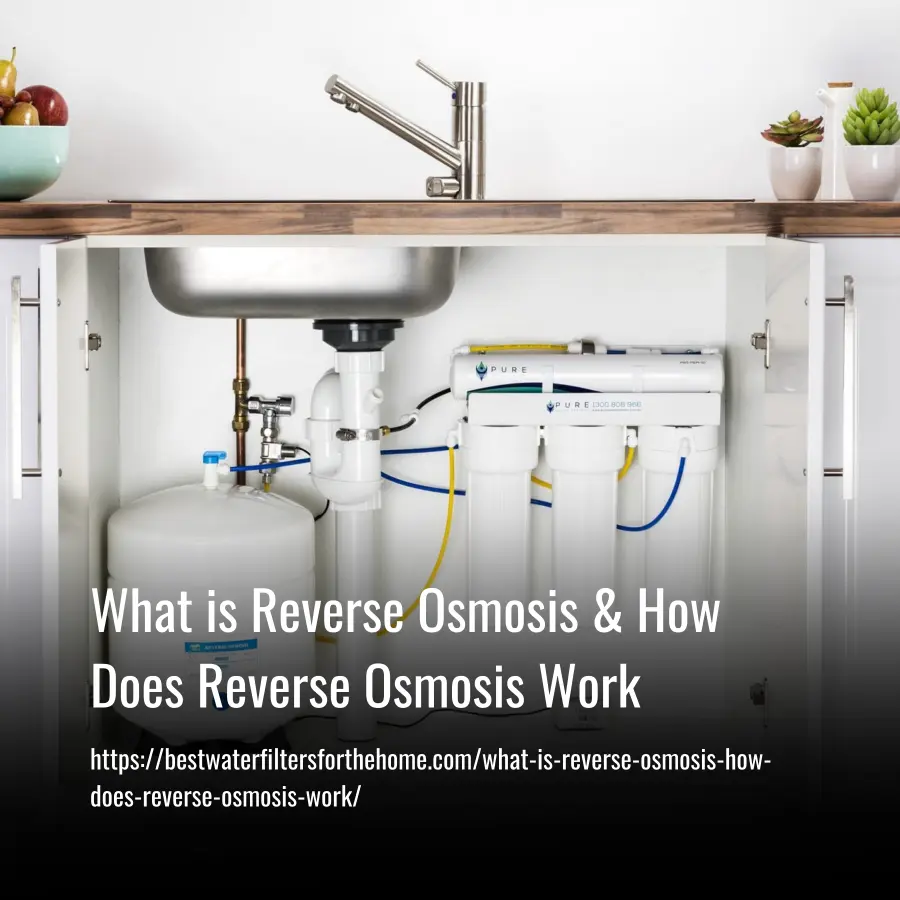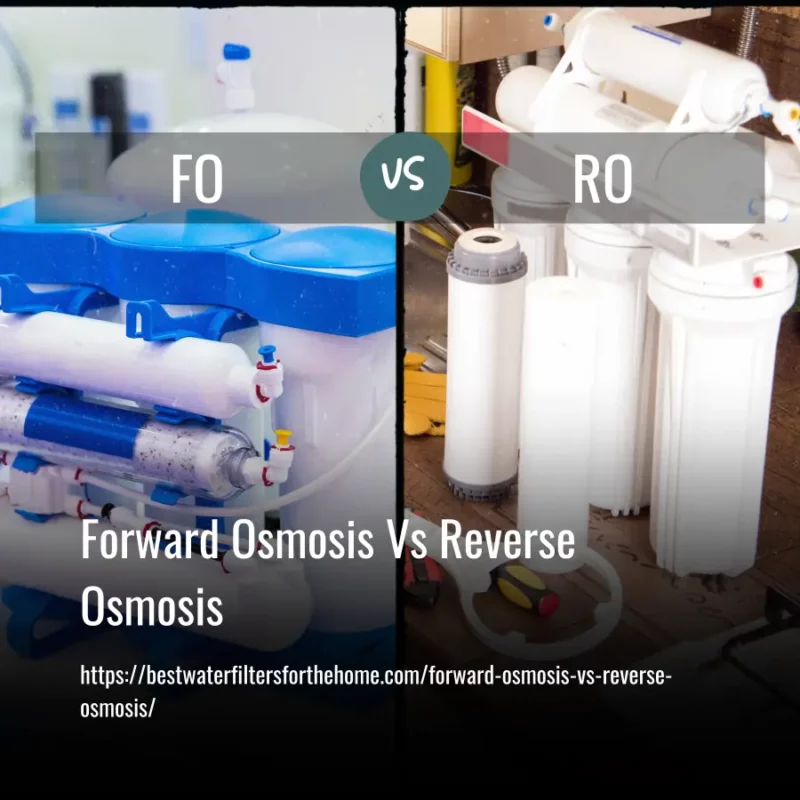This post contains affiliate links. As an Amazon Associate, we earn from qualifying purchases.
Reverse Osmosis is a water filtration system that removes impurities from drinking water. This type of water filter works by forcing water through a membrane made of special materials.
Reverse Osmosis systems are used in homes, businesses, restaurants, hotels, hospitals, schools, and even military bases. They remove contaminants such as chlorine, fluoride, heavy metals, bacteria, viruses, and parasites.
Reverse Osmosis Systems are also known as RO systems because they remove dissolved solids from water. In fact, most bottled waters sold in stores are filtered through a reverse osmosis system.
In this guide, I’ll explain what is reverse osmosis and how it works. If you’d like to learn more about reverse osmosis systems, read on!

What is Reverse Osmosis?
Reverse osmosis is a water purification system that removes impurities from tap water using a semi-permeate membrane. It works by forcing water through a semipermeable membrane, which filters out contaminants and large particles like chlorine, salt, or dirt.
In order to get rid of contaminants and sediments, you must force water through the membrane. You accomplish this by applying pressure to the water. The pressure forces the water through the membrane. Once the water passes through the membrane, it flows into a holding tank where it collects until it can be used again.
Reverse osmosis is great for filtering out microorganisms, which you definitely don’t want to drink. It leaves only pure H20 behind.
Reverse osmosis is a great way to get clean, fresh water without spending a lot of money.
How Does a Reverse Osmosis System Work?
Reverse osmosis works by forcing water through a semipermeable membrane. Water molecules flow through the membrane, but larger particles cannot. As a result, only pure water passes through the membrane.
A typical reverse osmosis system consists of four main components: carbon prefilters, an RO membrane, a carbon post-filter, and a re-mineralizer.
1. Carbon Prefiltration
After entering the RO system, the water flows through a carbon prefilter. Adsorption occurs here, meaning that any contaminants are captured and prevented from passing through the membrane.
2. RO Membrane
While carbon filters offer effective filtrations, they can’t remove dissolved salts or minerals. This is where an R0 membrane can help. A semi-permeable membrane can remove up to 99% of all inorganics. The majority of impurities are simply too small to squeeze through the membrane’s pores.
3. Carbon Post-Filter
There are a few contaminants that made it through the RO membrane, and these are removed during the final polish stage, which typically uses carbon post-filters. Again, chemicals and sediments will be targeted in this filtering stage.
4. Re-Mineralization Filter
It’s becoming more common for some of the best reverse osmosis systems to include a final filter, a remineralization filer. Reverse osmosis remove dissolved minerals and salts such as sodium, calcium, magnesium, and potassium, reintroducing these minerals can improve the pH and taste of water, making it less susceptible to further contamination.
What Does a Reverse Osmosis System Remove?
Reverse osmoses remove up to 99.9 percent of all total dissolved solids (TDS), including heavy metals, chlorine, fluoride, bacteria, viruses, and pesticides.
However, there are certain contaminants that reverse-osmosis cannot remove completely, including hydrogen sulfide gas, pesticides, and certain organic compounds.
Advantages of Reverse Osmosis
There are several benefits to using reverse osmosis systems. One of the biggest benefits is that bacteria, viruses, and pyrogens are removed from the water. This means that the water is safe to drink.
Another advantage is that the unit is small and requires little space. And lastly, the membrane lasts longer than traditional filters.
In addition to those benefits, there are several reasons why you should consider getting a reverse osmosis system for your home.
First, it’s cost-efficient. Second, it’s environmentally friendly. Third, it’s convenient. Fourth, it’s simple to install. Fifth, it’s easy to maintain. Sixth, it’s energy efficient. Seventh, it’s quiet. Eighth, it’s portable. Ninth, it’s versatile. Tenth, it’s affordable. Lastly, it’s reliable.
Disadvantages of Reverse Osmosis
There are several disadvantages to using reverse osmosis systems. One disadvantage is that cellulose acetate membranes have a limited pH tolerance.
These membranes degrade at temperatures greater than 40 degrees Celsius. Another disadvantage is that they are vulnerable to bacteria. And finally, they eventually hydrolyze.
Does Reverse Osmosis Waste Water?
Reverse osmosis systems send water with rejected contaminants down a drain, instead of sending those contaminants to the sewer line. This means that there’s less water being flushed down the toilet, and less water being pumped out of the ground.
But the wastewater still needs to be cleaned before it goes to the drain. And since we care about the environment, we should try to reduce the amount of water that ends up in the drain.
That’s why reverse osmosis systems include a brine tank. Brine tanks hold the wastewater until it’s purified enough to be released into the environment.
So although reverse osmosis systems do produce wastewater, it’s actually used for a purpose. And if you think about it, it makes sense. After all, we wouldn’t want to flush away any of the nutrients that were originally in the water. We’d rather keep them where they belong—in the soil.
How to Reduce Wastewater in an RO System
An RO removes water from wastewater using reverse osmosis (RO). Permeate Pumps (PPM) reduce the water that passes through the reverse osmosis membrane by up to 75% or more.
And since it’s connected directly to the RO system, you won’t have to worry about clogging pipes.
An automatic shut-off valve will stop the flow of water to your drain once the storage tank reaches capacity. This prevents wasted water from draining down the sink.
Use the rejected water for landscaping or for artificial lakes. Rejected water has high levels of TDS, but it’s safe to add to your landscape or lake.
Is Reverse Osmosis Good for the Environment?
Reverse osmosis is great for the environment because it removes harmful chemicals from wastewater. But if you live in an area where there isn’t enough rainfall to dilute the wastewater, then you may end up using more energy to produce clean drinking water.
A reverse osmosis system uses less electricity than a traditional water purification method called distillation. Distillation requires heating water until it evaporates, leaving behind only pure water. However, reverse osmosis doesn’t require any heat, so it saves energy.
But reverse osmosis still produces a lot of waste. You’ll need to dispose of the remaining brine water. Some municipalities recycle the brine water, but others send it to landfills. Either way, it’s important to know whether your municipality recycles brine water.
Reverse Osmosis Vs. Bottled Water
A reverse osmosis system purifies water just as well as bottled water, but it doesn’t require any extra water or energy to produce. And since it’s constantly producing high-quality water, there’s no need to buy cases of bottled water every week.
With a reverse osmosis water filtration system, you can enjoy all the benefits of bottled water without the wastefulness of bottled water production. You can fill your favorite stainless steel water bottles with reverse osmosis water and keep them in your refrigerator.
Reverse Osmosis System vs. a Water Softener
A water softener is great if you have hard water. But if you already have a reverse osmosis unit, you should consider installing a water softener after it. Hard water can shorten the life of your RO membrane. And since you’ve already invested in a RO system, why would you replace it?
Instead, install a water softener to remove any minerals that cause stains or clogs. Then, once your RO system is done filtering out impurities, you can stop adding chemicals to your water. You won’t have to worry about replacing your RO membrane anymore.
So if you have hard water, consider getting a water softener. It will save you money and keep your RO system working longer.
Is Reverse Osmosis Water Good for You?
Reverse osmosis water systems remove dissolved contaminants that you can’t see but that could make your skin break out or cause health problems. But if you’re concerned about drinking water that may be contaminated with chemicals, reverse osmosis is a great option.
Water is essential for life. It keeps our bodies hydrated, lubricates our joints and muscles, and helps maintain good health. We don’t need any minerals to do those things; we get plenty from food. And if you want more minerals, you should eat your fruits and vegetables instead of drinking water.
Some mineral content is fine to consume, but the Environmental Protection Agency recommends that the amount of total dissolved solids (TDS) in water shouldn’t exceed 500 parts per million (ppm). Most of the United States has TDS levels that far exceed this limit, and could benefit from a reverse osmosis system.
So if you want to know whether reverse osmosis water is good for you, the answer is yes. It’s safe and effective for removing harmful substances from tap water.
Where to Use a Reverse Osmosis System
A reverse osmosis system is used to purify water. You can find reverse osmosis systems in homes, restaurants, hotels, offices, schools, hospitals, farms, and even in RVs.
In homes, you can use reverse osmosis to purify drinking water or tap water. You can also use a reverse osmosis system to purify well water. For restaurants, hotels, and offices, you can use a reverse osmosis system to clean water for sinks, toilets, and fountains.
Schools can use a reverse osmosis system to purify drinking water for students and staff. Hospitals can use a reverse osmosis system to purify water for patients and medical equipment.
Farms can use a reverse osmosis system to purify water to drink and wash produce. An RV can use a reverse osmosis system to purify water in its tanks.
How Long Do Reverse Osmosis Systems Last?
A reverse osmosis system lasts anywhere from 10 to 15 years. But if you keep it well maintained, it can last longer. You can extend its life by changing the prefilter and/or post-filter regularly.
And depending on your water conditions, you may need to replace the RO membrane every two or four years.
FAQs
What is the Principle of Reverse Osmosis?
Reverse Osmotic Purification (RO) is a method for removing impurities from liquids by forcing them through a semi-permeable barrier under pressure.
What Does Reverse Osmosis Mean?
A process by which a solution passes through a semipermeable membrane in the opposite (to natural) way when subjected to a hydrostatically higher pressure than the osmotic force.
Is Reverse Osmosis Water Safe to Drink?
According to the World Health Organization, distilled or reverse osmosis water has too few minerals to be considered safe for human consumption. And in fact, some studies suggest that these types of waters could cause negative health issues for humans.
Conclusion
Reverse osmosis (RO) is an advanced water filtration system that uses pressure to force water molecules through membranes. This allows us to filter out contaminants such as bacteria, viruses, heavy metals, pesticides, herbicides, pharmaceuticals, and even chlorine.
RO systems are typically installed in commercial applications where large volumes of water must be purified. However, residential RO systems are now available that allow homeowners to purify drinking water for themselves and their families.


